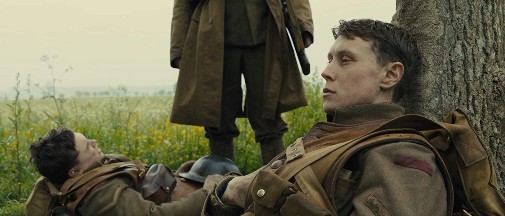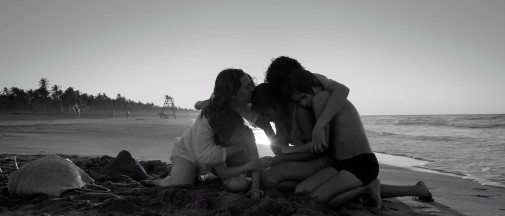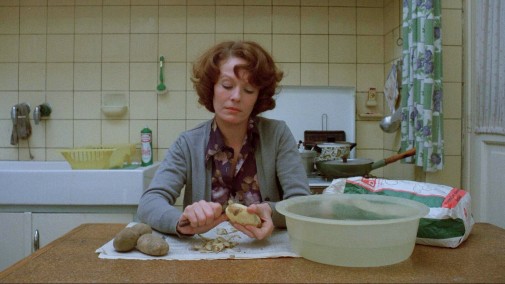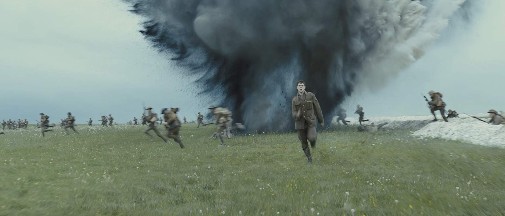A long take is a held breath.
 Wednesday, January 15, 2020 at 10:30AM
Wednesday, January 15, 2020 at 10:30AM 
Long takes are a constant subject of fascination for filmmakers. The technical challenge and opportunity to show off one's craft makes many directors salivate. At least, that's what, as an audience member, it sometimes feels like. To characterize long continuous shots (sometimes feature-length) as a mere tool of formalistic showmanship would be wrong, though. In the right film and with the right team this trick can be transformative, capable of bending the audience's perception of time, and their emotional attachment to what they're watching.
In 1917, Sam Mendes uses the long take as a key to sensorial immersion and ever-tightening tension. Cuts are essentially a blink or breath, a repositioning of the eye and recalibration of the senses. It's a cinematic convention that can bring comfort to the viewer. When you take it away, the action never stops; it's as if there's no time to breathe or to disengage. A long take is a held breath and it can be a gloriously suffocating thing to experience…

Of course, Sam Mendes isn't interested in creating a purely punitive explosion of audiovisual stimuli. For as much as his grand epic is a portrait of violent devastation, it's also a spectacle. Roger Deakins' cinematography may show us horrible sights, but they are lit like dreamlike reveries full of milky hazes and inky shadows, more beautiful than terrifying. In 1917, war may be hell, but war is also a show worth watching in detached wonderment.
 Roma
Roma
Alfonso Cuarón is another director who loves the long take. The horizontal motion and crashing waves of Roma's climax are made more monumental because we don't have permission, via cutting, to relax or look away. Children of Men's marathon-length shots are set pieces contained in a single gesture, their byzantine complexity an expression of primordial chaos. Movement can be a crucial part of this technique, helping override conventional notions of cinematic time to create something more abstract and, incongruently, more present too.]
 Victoria
Victoria
In Sebastian Schipper's Victoria, the everlasting take is a gateway to a world of hyperreality, where everything seems painfully realistic though also like a hallucination brought upon by exhaustion. It's the exhaustion of the characters and the exhaustion of the breathless audience.
 Russian Ark
Russian Ark
The continuous shot as a conduit to a world of fluid dream and chronological dystrophia is present in Alexander Sokurov's famous Russian Ark. In that reverie on Russia's history, centuries are contracted into a somnambulistic wander through the Hermitage. Because he doesn't cut, Sokurov defies our understanding of rightful order, of the passage of time and can, thus, contort it at will, on a first-person tour of ghostly apparitions and national trauma.
 Jeanne Dielman, 23 quai du Commerce, 1080 Bruxelles
Jeanne Dielman, 23 quai du Commerce, 1080 Bruxelles
But movement isn't everything.
Some great long takes are static, inviting the audience to let its eyes wander through the tableau. This makes the spectator into an active participant in the dialogue with the artist and the film. In Chantal Akerman's cinema, this theatrical stillness and extension of time is particularly powerful. A kitchen interlude can become a window into a woman's soul and a tree beaten by the wind is a mystery beckoning the audience. Come closer, it seems to whisper.
A long take can make us aware of our condition as observers and also makes us more involved. It's a miraculous piece of technical wonder that's too often evaluated only in terms of craft and engineering wizardry. The magic of it lies in the way it changes our perceptions, how it erupts emotional reactions the cut can't create and how it can break the rules of conventional film language.

If the makers of 1917 deserve accolades, it's not because of the pragmatic difficulty of the challenge. It's because of the tension they may have created, the awe they inspired and the way they took our breath away.



Reader Comments (16)
Great post! Just saw 1917 last night, and I was preparing to be annoyed by long takes as gimmick, and I was a bit, but also loved the instances where they were artfully applied.
Thank you for mentioning Victoria, one of my favorite films of the last decade. What really impressed me about the one-take was the way we were confronted with living with the consequences of the characters' actions. There was no cutting away and jumping to the conclusion or to some other action. We had to endure the ramifications of each choice the characters made.
Russian Ark is also a favorite.
Miklos Jancso is pretty obscure now, but one of my first experiences with a "long-take" movie was his The Red and the White. It's a great (anti?-)war movie.
I love the one, long take in the coffee shop in SECRETS & LIES between Cynthia (Brenda Blethyn) and Hortense (Marianne Jean-Baptiste). You cannot help but feel fully immersed in the birth of conversation between a mother and her biological daughter. Breathtaking.
Claudio-
How about that amazing stairwell fight sequence in ATOMIC BLONDE? That's my favorite long take I've ever seen.
ken s. -- I actually mentioned Miklos Jancso in this piece's first draft. I adore The Red and the White as well as Red Psalm. Great uses of long takes.
Joel M & DAVID -- Those are other two wonderful examples. I love both of them. I didn't have space to mention every long take I appreciate (this would be a book instead of a blog post otherwise), but it's great to have them mentioned in the comments.
My favorite long takes are the love scene in A Place in the Sun and the opening ones in Touch of Evil and The Player.
You cannot talk about these matter without mention Russian Ark, what a beautiful film. I like the dynamical persecussion scene in El Secreto de Sus Ojos too.
But my favorite could be the scene of Bienvenido-Welcome when the cast & crew take a break of filming. It makes you feel inmerse with the familiar routine of people who works in the world of movies.
Idle doubt: Is 'long take' the "official" term to this? In spanish is known as 'Plano secuencia' that according to Google translator the english equivalent Is 'Sequence shot'
César Gaytán -- Russian Ark is splendorous, I love it. The football stadium scene in El Secreto de Sus Ojos was rivetting too, though I'm not as fond of the film as a whole. Never watched Bienvenido but it's going on my watchlist. Thanks for the recommendation.
In Portuguese, it's called "plano sequência" like in Spanish. However, I believe in English a sequence shot is considered a type of long take, rather than a denomination that includes things like the Jeanne Dielman examples, when there are no different individual scenes developed within the same continuous take.
It's such a shame that the best one-take achievement of 2019 is so overlooked: "The Body Remembers When the World Broke Open." It's totally unflashy and yet absolutely brilliant in how it confers aesthetic value, wholeness, and cultural worthiness on its First Nations subjects by making them so radically visible in what is essentially real time. And the film is on NETFLIX! Watch it, people!!!
Jonathan -- I really want to watch it, but it's not on Netflix Portugal. Guess I'll have to trust the power of VPNs and hope for some good internet connection. Glory to the holy wifi! Seriously though, I've heard great things about that film. Thank you for the feedback and the recommendation.
I would also have to recommend UTOYA: JULY 22, Erik Poppe's one-take observance of the terrorist mass murder on the Norwegian island of Utoya in 2011, from the perspective of a teenage camper. I though of it a lot whilst watching 1917 - whilst technically brilliant and well worth watching, one of the few technical criticisms I would haveof Mendes' film is that I always felt like an observer, rather than being emotionally absorbed in the story. Whereas UJ22 grabs you by the throat and throws you in the middle of the tragedy, so much so that you felt the same amount of fear as the protagonists (one other technique they used to great effect is that they never show the gunmen). I still remember when the lights went up, the members of the audience had to debrief with each other, perfect strangers most of us, to ease ourselves into the more placid real world again.
(UJ22 is available o SBSOnDemand in Australia. Other regions will have to investigate themselves.)
1917 may not quite top my personal ballot for best lensing of the year, but you won't hear me complain about Deakins or Mendes each getting a second Oscar. That said, I think perhaps the person who most deserves a second Oscar for the film is Dennis Gassner, for whom the task of designing and constructing a to-scale Western Front obstacle course that would fit the film's conceit was herculean.
@Claudio
In case you're interested to watch it, the movie is Bienvenido-Welcome directed gy Gabriel Retes from 1994 and is my favorite movie of all time. (In big part because is mexican, i have to admite it)
I hope Birdman hasn't fallen out of favor so quickly...
Jonathan -- I ended up watching "The Body Remembers..." tonight and it is extraordinary, indeed. I'm very grateful for the recommendation.
Guestguestguest -- I've never been too fond of "Birdman'"s use of the long take. At first, it seems like the mechanism is there to illustrate a radically subjective perspective. We're so entrenched in the protagonist's psyche that his dreams and hallucinations are seamlessly inserted into everyday life, no cuts to compartmentalize how he sees the world from how we, the audience, see it. But then the movie keeps betraying that throughline with scenes completely divorced from the main character's experience, even allying its aesthetic to the daughter's individual scenes. It makes no sense and always feels like a gimmick. A beautiful gimmick that makes great use of artificial lighting and theatrical clichés, but still a gimmick.
I'm sorry for my strong disagreement, but I am thankful for the feedback. It's great to have a discussion about this complicated film technique that can have such varied outcomes and purposes.
1917 is so much more than its long take. Complete masterpiece.